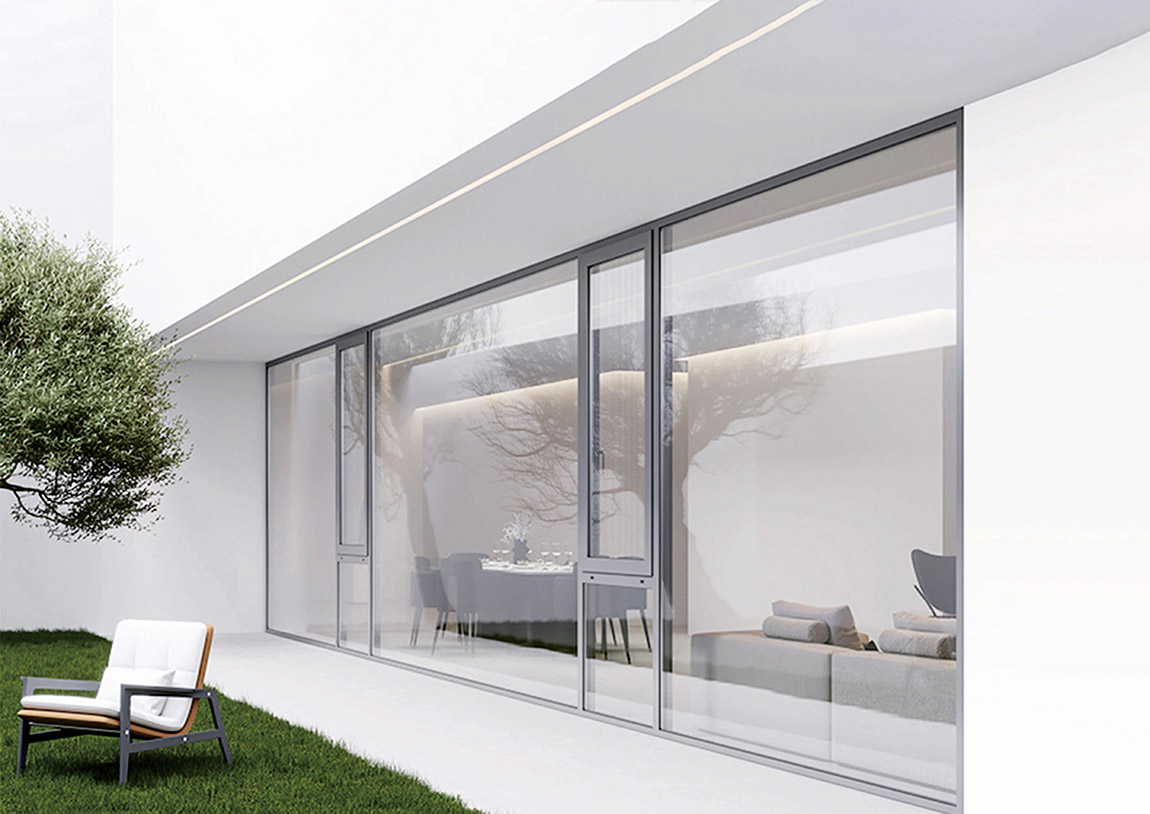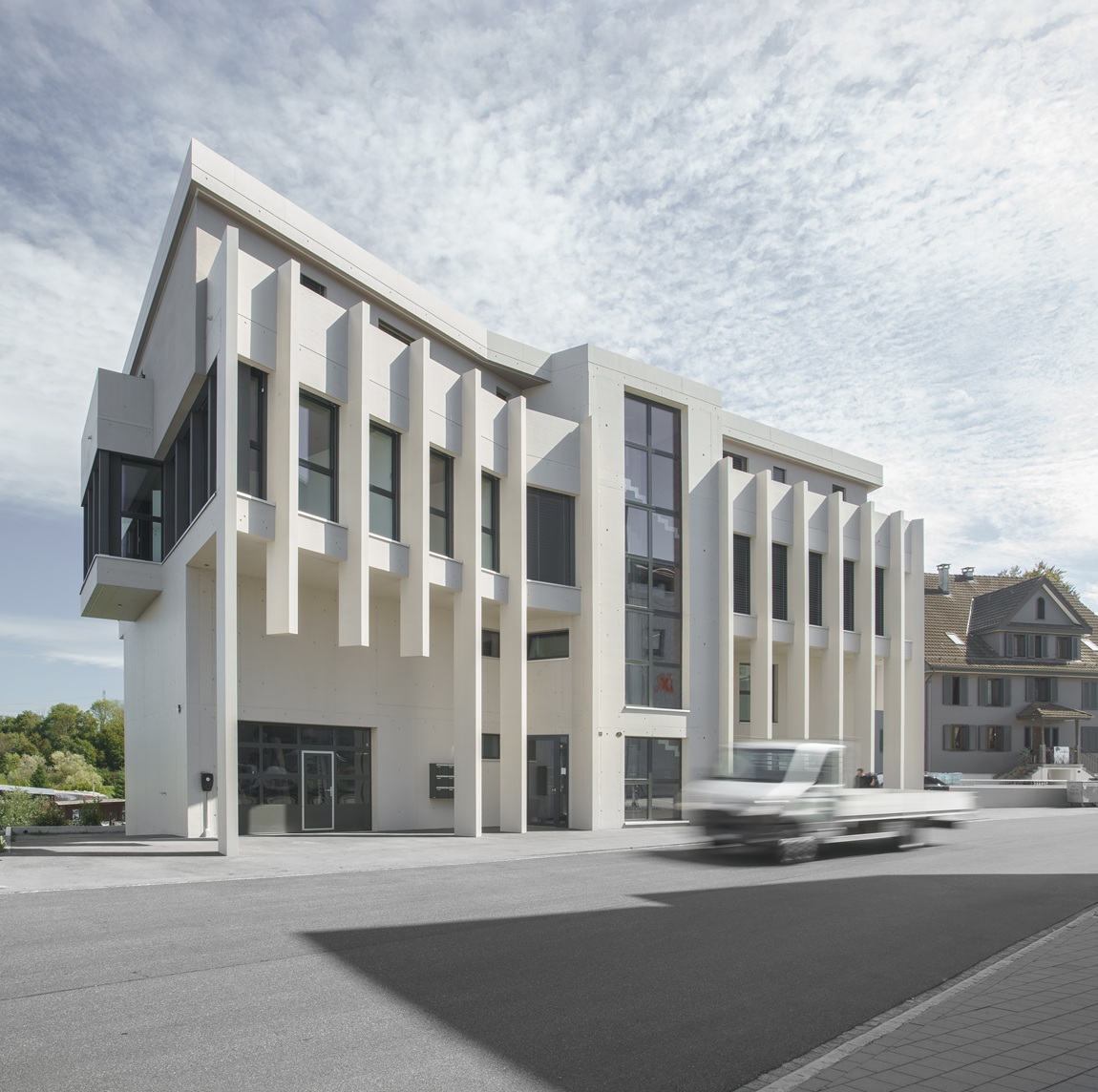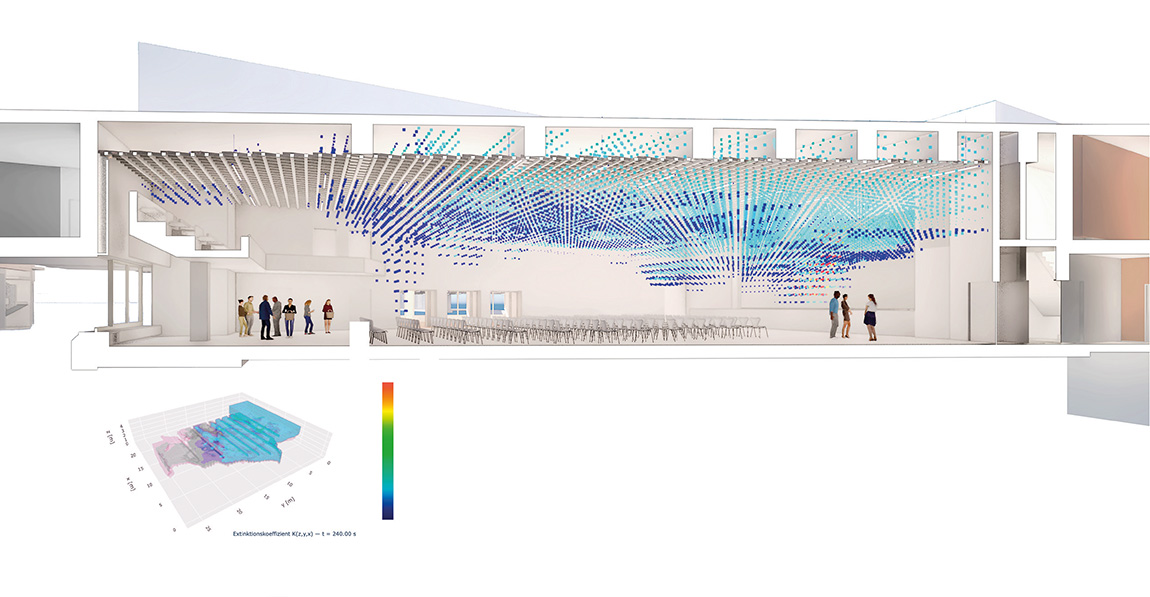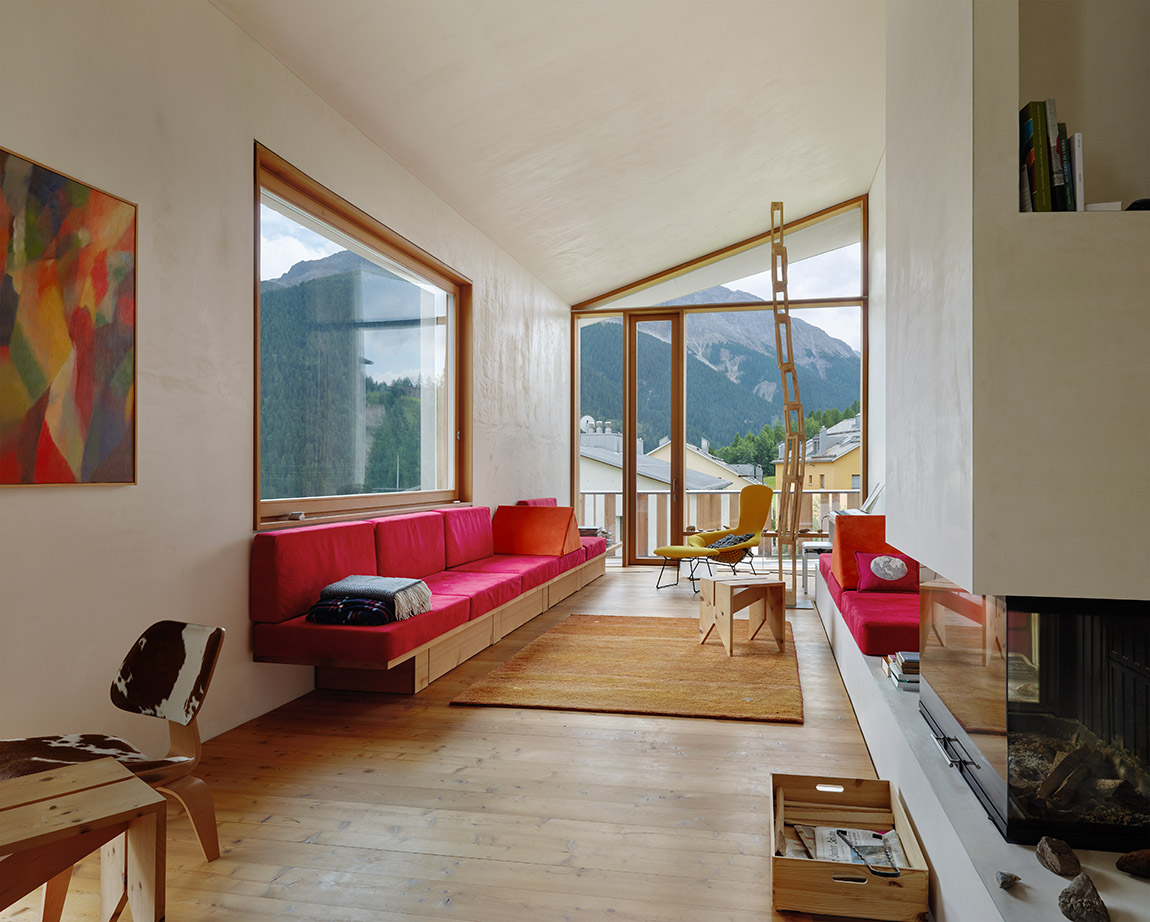Gresser Architects: Architecture as a symbiosis of the past and contemporary
TEXT: SILKE HENKELE
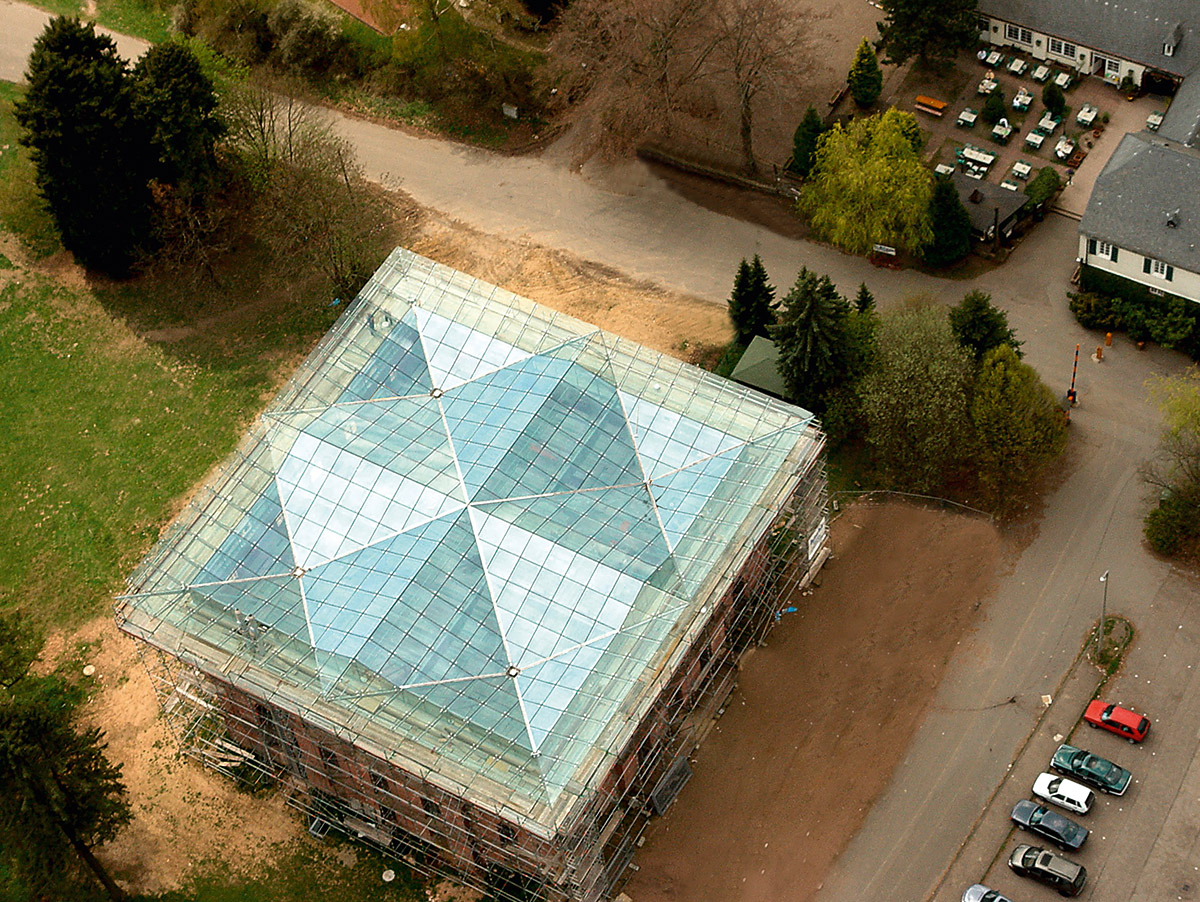
Aerial view of Platte Hunting Lodge - a ruin cannot have a roof; four cup-shaped structures made from glass shield the ruin. Photo: Hans Peter Gresser
Architecture is much more than the construction of buildings. It is a creative process that combines reason and emotion and has a lasting impact on the environment we live in.
Combining the old and the new, emphasising the history of a place with innovative accents – this is the task to which Hans Peter Gresser, Dipl. Ing. Architekt BDA dwb, has been dedicated to for over four decades.
An architect with a passion
Born in Clausthal-Zellerfeld in 1945, Hans Peter Gresser studied at the Technical University of Darmstadt. He began his career as a research assistant and lecturer in design under Günter Behnisch, the famous architect of the Olympic Stadium in Munich. In 1976, Gresser set up his own office in Wiesbaden.
A fantastic overview of his extensive work is provided by the architect himself in his 2023 book “Hausaufgaben”, a 650-page compendium of his projects and philosophical reflections.
The mission
What motivates the architect and what does architecture mean to him? The answer is as clear as it is obvious, because for Gresser, architecture goes far beyond the design of buildings. “The traces of past generations are everywhere,” says the architect. “I therefore see architecture more as a builder of bridges. Our task is to discover these traces, interpret and transfer them to the modern age. This creates an inseparable link between old and new, a new unity. For me, the old and the new are not mutually exclusive. They complement each other. Successful architecture does not hide behind the mask of the old. It integrates both aspects and unites them harmoniously.”
In addition to the harmonious symbiosis of old and new, another imported aspect in Gresser’s architecture is the perception of space.
Architecture as a gateway to many levels
“For some, the strength of a design lies in its symbolic power, for others in its physicality, its use of light, its spatial design or functionality. Architecture works on all these levels – levels that go far beyond its physical structure.”
This understanding is Gresser’s guiding principle. Inspired by the tradition of the Roman architectural theorist Vitruvius, Gresser Architects’ designs combine the three timeless principles of utilitas (utility), firmitas (strength) and venustas (beauty) into a harmonious overall concept – a concept born of passion.
Great ideas through passion
“Good architecture is not the result of anonymous committees or collective decisions, but of the commitment of individuals”. It is this awareness that gives rise to designs created with vigour and passion for human and creative needs. The results are not only functional spaces, but also innovations that enrich people’s lives and improve their quality of life in a sustainable way
To achieve this goal, Gresser stresses that the cooperation of clients is essential. They ought to be willing to embrace such ideas and open their minds to arguments other than purely economic considerations. “Close collaboration with clients is always essential. Architects need to maintain their creative vision, but they also need to communicate to their clients the importance of aspects such as quality of life in the design of a place or building.”
Influences and inspirations
One of Gresser’s main inspirations is the Japanese philosophy of wabi-sabi, which seeks beauty in the unassuming and ephemeral. “For me, this philosophy is inexhaustible; it shows me endless possibilities. On his first visit to Japan, the famous architect Bruno Taut made a point of first visiting the Katsura Villa, a kind of imperial secondary residence in Kyoto.
For me, the aesthetics of Zen gardens and the simple elegance of Japanese architecture, as exemplified by the Katsura Villa, are the epitome of perfect design.”
Another example of his creative versatility and ability to engage with new cultural contexts and translate these inspirations into buildings is the South India Art Museum in the southern Indian state of Kerala. The building exudes serenity and spirituality. One side is reminiscent of the bow of a ship sinking into the sea, both visually and symbolically. As the place is not only an exhibition space but also a place of meditation, the museum follows the shape of a mandala, which helps believers to meditate.
The revitalisation of Platte Hunting Lodge near Wiesbaden, for which Gresser was awarded the Hessian State Prize for Architecture in 2008, is a distinctive work from Gresser’s extensive portfolio. It captivates the viewer, draws people in and impressively demonstrates how old and new can enter into a harmonious dialogue.
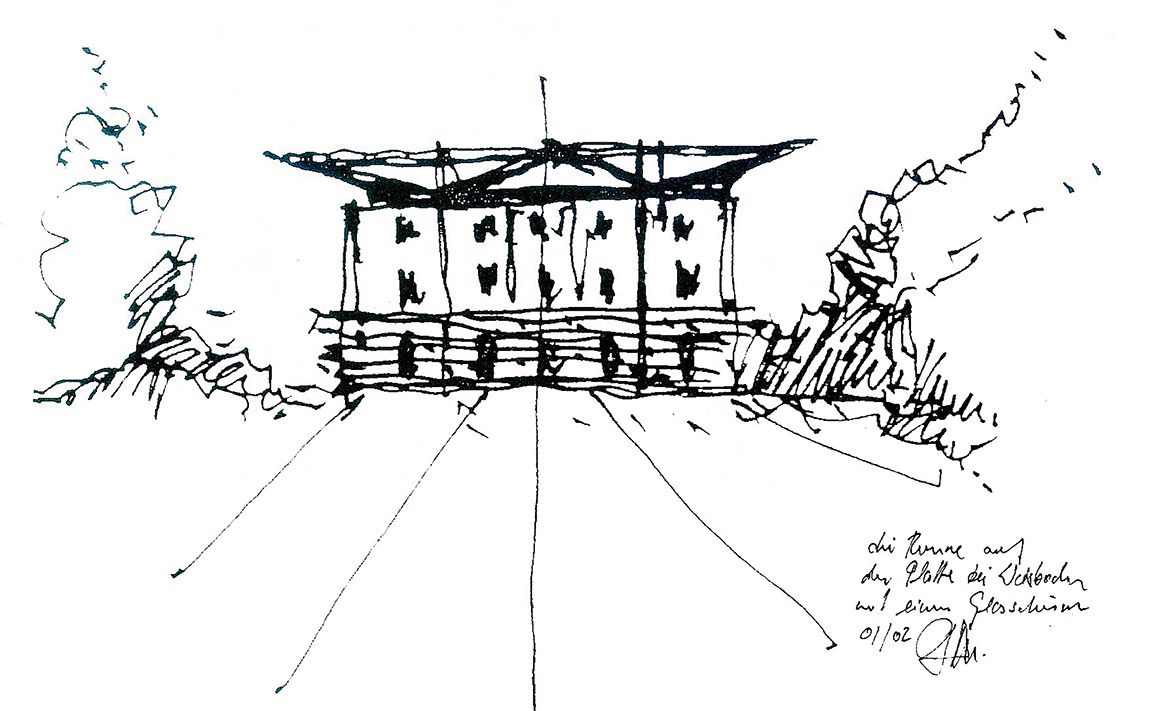
First sketch of Platte Hunting Lodge ‘The ruin on the Platte close to Wiesbaden with a glass dome’. Sketch: Hans Peter Gresser
Challenges of urban development
Overall, Gresser is critical of current trends in architecture and urban development: ‘In big cities, we see more and more interchangeable buildings. This is outdated and lacks inspiration, “ says Gresser. “A successful example of timeless and modern architecture is the Olympic site in Munich, designed by my teacher Günter Behnisch. These designs stand for innovation and airiness and demonstrate the inspiring and stimulating power of architecture.”
Does Gresser also see positive examples? The architect answers this question by looking across the Atlantic: “For me, California is an example of good architecture. The avant-garde buildings there are setting standards for innovative design and sustainable construction. They show how architecture can be progressive without dominating its surroundings.”
Looking to the future
Hans Peter Gresser’s designs combine tradition and innovation in a unique way. So, after all the projects he has completed, does the architect still have a particular dream? “My wish is to build a new monastery – a place of contemplation where architecture and spirituality merge. Such projects challenge us to break new ground and create spaces with a deeper meaning.”
Gresser Architects are setting new standards in their pursuit of architecture that preserves history while creating space for the new. Their approach demonstrates how creativity can make a lasting difference to our physical environment and understanding of architecture.
www.gresser-architects.com
“Hausaufgaben”: ISBN 978-3737405034
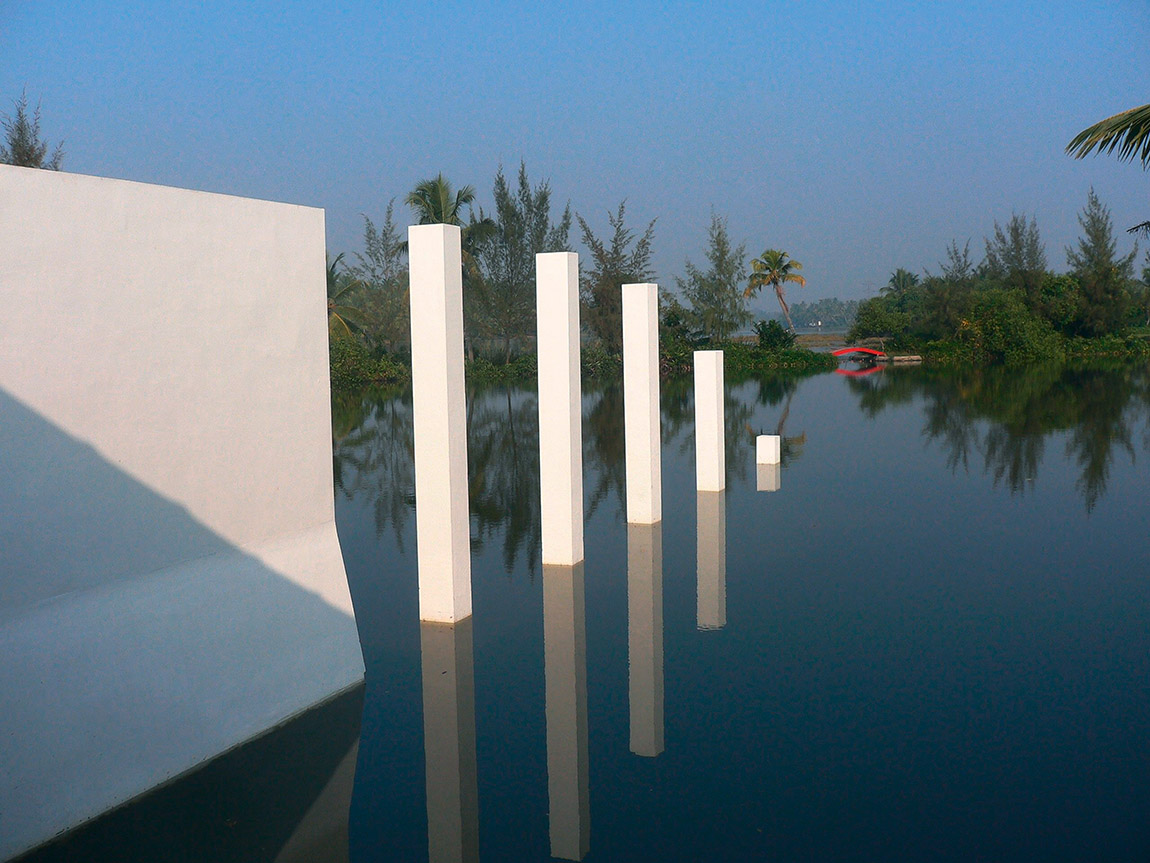
The wall of the museum transforms into columns that dissolve into the lake. Photo: Hans Peter Gresser
Gresser Architekten: Architektur als Symbiose von Vergangenheit und Moderne
Architektur ist weit mehr als das bloße Errichten von Gebäuden. Sie ist ein kreativer Prozess, der Ratio und Emotio verbindet und Lebenswelten nachhaltig prägt.
Altes und Neues verbinden, die Geschichte eines Ortes mit innovativen Akzenten zu unterstreichen – dieser Aufgabe widmet sich Hans Peter Gresser, Dipl. Ing. Architekt BDA dwb, seit über vier Jahrzehnten.
Ein Architekt mit Leidenschaft
1945 in Clausthal-Zellerfeld geboren, studierte Hans Peter Gresser an der Technischen Hochschule Darmstadt. Seine berufliche Laufbahn begann er als wissenschaftlicher Assistent und Lehrbeauftragter für Entwerfen bei Günter Behnisch, dem berühmten Architekten des Olympiadaches in München. 1976 gründete Gresser dann sein eigenes Büro in Wiesbaden.
Einen fantastischen Überblick über sein umfangreiches Werk dokumentierte Gresser 2023 in seinem Buch “Hausaufgaben” – ein 650-seitiges Kompendium, das seine Projekte und philosophischen Reflexionen zusammenfasst.
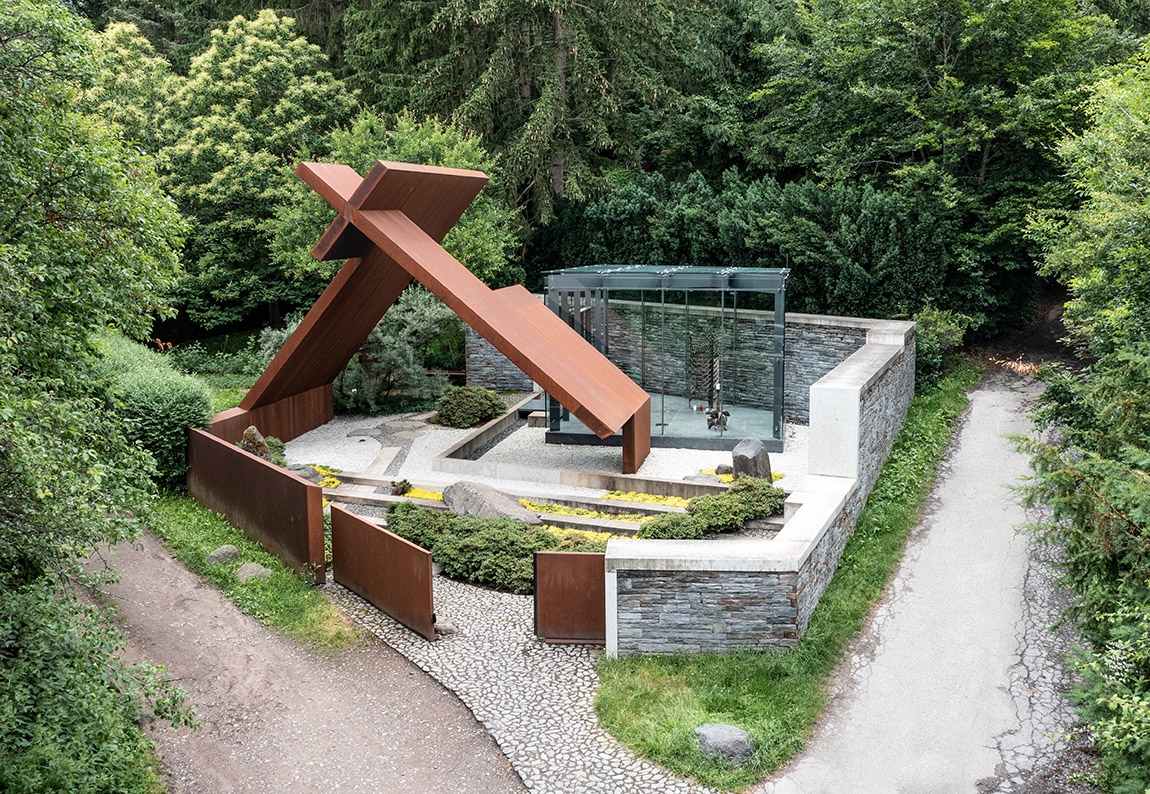
Die Anlage als ‚hortus conclusus’. Foto: Stefan Metz
Die Mission
Was bewegt den Architekten, was bedeutet Architektur überhaupt für ihn? Die Antwort ist ebenso klar wie einleuchtend, denn für Gresser geht Architektur weit über die Gestaltung von Gebäuden hinaus.„Vergangene Generationen haben überall ihre Spuren hinterlassen“, so der Architekt. „Ich sehe die Architektur daher eher als Brückenbauer. Unsere Aufgabe ist es, diese Spuren zu entdecken, zu interpretieren und in die Moderne zu überführen. So entsteht eine untrennbare Verbindung zwischen Alt und Neu, eine neue Einheit. Alt und Neu sind für mich keine Gegensätze, die sich ausschließen. Sie ergänzen sich. Gelungene Architektur tarnt sich nicht mit der Maske des Alten. Sie integriert beide Aspekte und führt sie zu einer harmonischen Einheit zusammen.“
Neben der harmonischen Symbiose von Alt und Neu spielt für Gresser ein weiterer Aspekt eine große Rolle in der Architektur, nämlich die Wahrnehmung von Räumen.
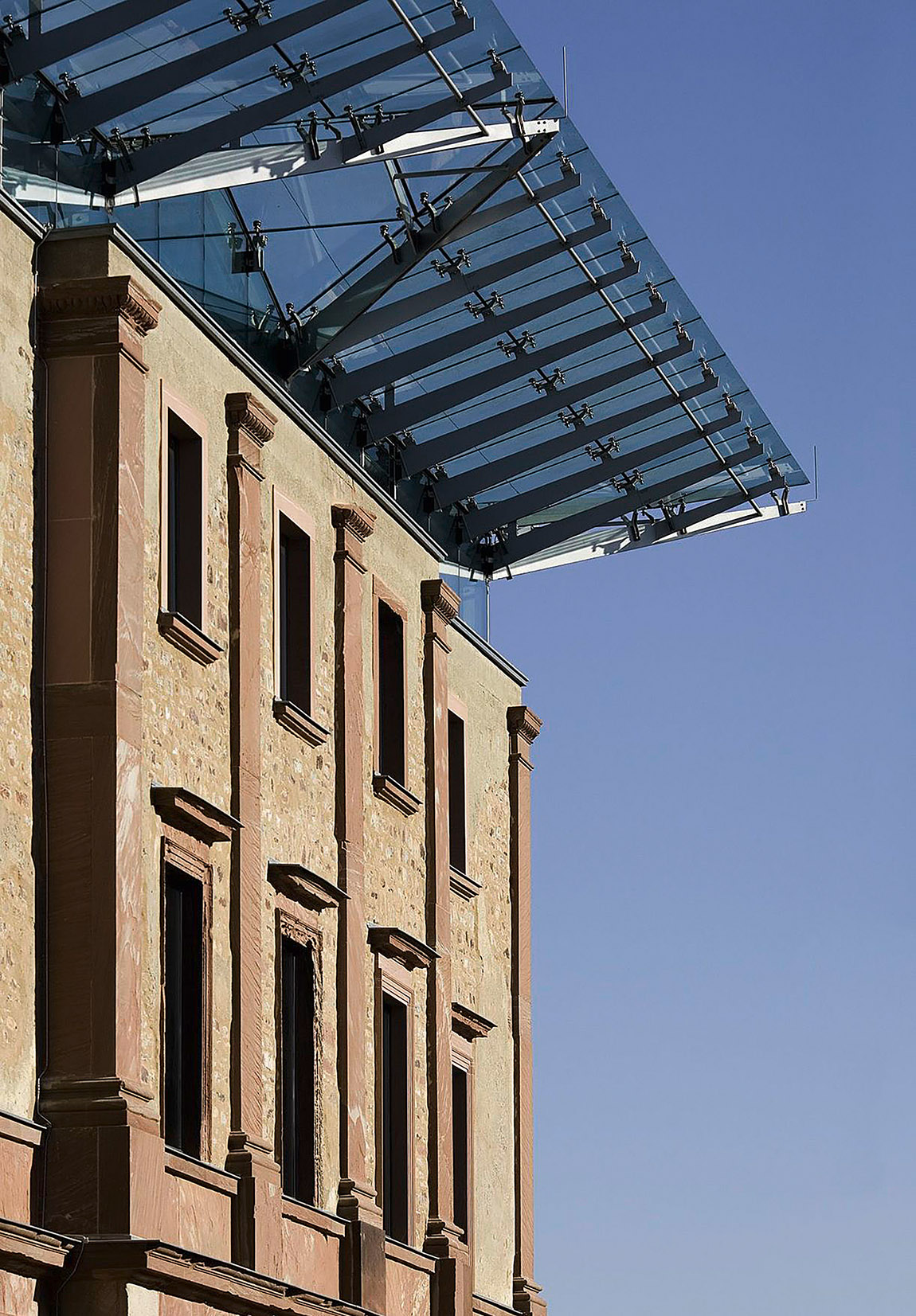
Glasschirm gleich einem Segel. Foto: Christian Welzel
Architektur als Zugang zu vielen Ebenen
„Für manche liegt die Stärke eines Entwurfs in seiner Symbolkraft, für andere in der Körperlichkeit, der Lichtführung, der räumlichen Gestaltung oder der Funktionalität. Architektur wirkt auf all diesen Ebenen – weit über ihre physische Struktur hinaus.“
Dieses Verständnis prägt sein Leitbild. Inspiriert von der Tradition des römischen Architekturtheoretikers Vitruv verbindet das Büro in seinen Entwürfen die drei zeitlosen Prinzipien Utilitas (Nutzbarkeit), Firmitas (Dauerhaftigkeit) und Venustas (Schönheit) zu einem harmonischen Gesamtkonzept – einem Gesamtkonzept, das aus Leidenschaft entsteht.
Große Ideen durch Leidenschaft
„Gute Architektur entsteht nicht durch anonyme Gremien oder kollektive Entscheidungen, sondern durch die Hingabe Einzelner“. Aus diesem Bewusstsein heraus entstehen Entwürfe, die mit Elan und Leidenschaft für menschliche und gestalterische Bedürfnisse kreiert werden. So entstehen nicht nur funktionale Räume, sondern Innovationen, die das Leben der Menschen bereichern und ihre Lebensqualität nachhaltig verbessern.
Gerade hier sei die Mitarbeit der Bauherren gefragt, betont Gresser. Sie müssten bereit sein, sich auf solche Ideen einzulassen und rein ökonomische Überlegungen für andere Argumente öffnen. „Eine enge Kooperation mit Auftraggebern ist immer essenziell. Architekten müssen ihre gestalterische Vision bewahren, aber im Dialog mit den Bauherren auch eindringlich vermitteln, wie wichtig Aspekte wie Lebensqualität für die Gestaltung eines Ortes oder Gebäudes sind.“
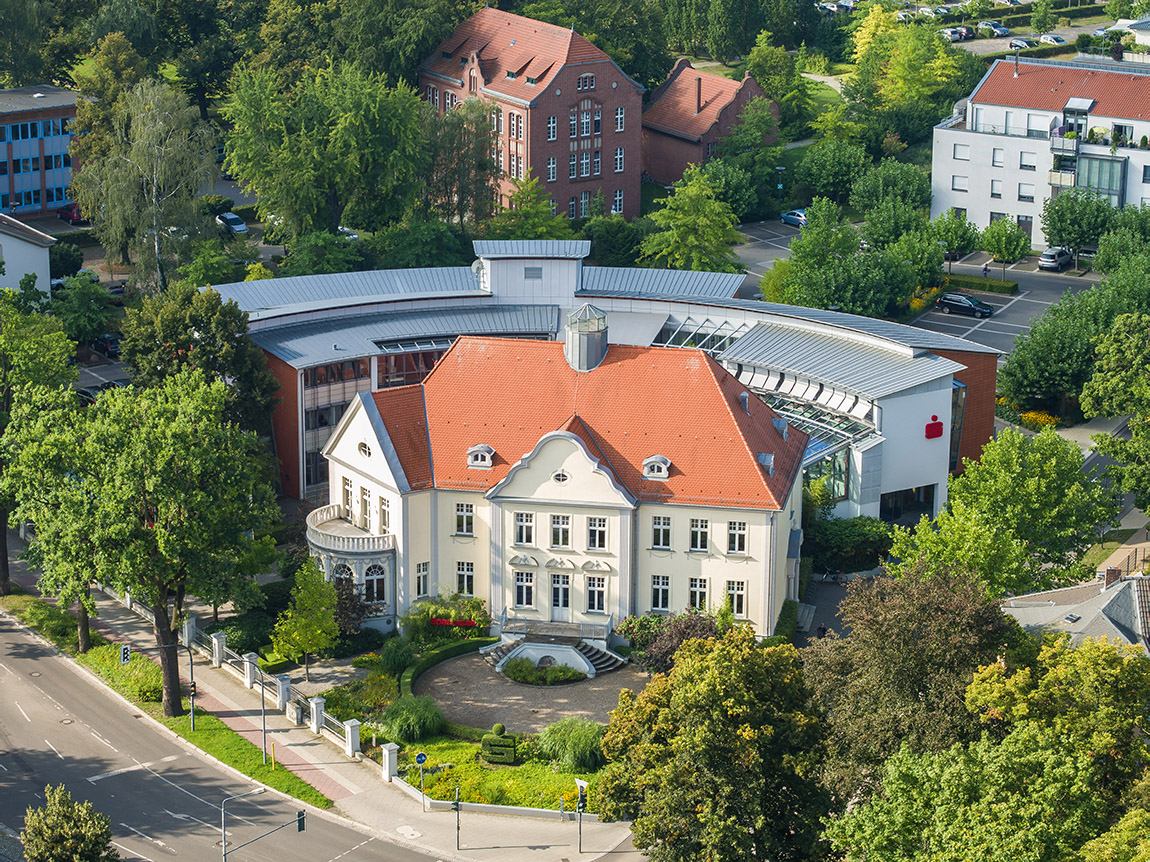
Bergmann‘sche Villa (als ‚Residenz’) mit ergänzendem Neubau (als ‚Kanzlei’) aufgebaut wie eine Botschaft. Foto: Stadtsparkasse Neuruppin
Einflüsse und Inspirationen
Eine der wichtigsten Inspirationsquellen Gressers ist die japanische Wabi-Sabi- Philosophie, die Schönheit im Unscheinbaren und Vergänglichen sucht. „Diese Philosophie ist für mich unerschöpflich, sie zeigt mir unendlich viele Möglichkeiten. Der berühmte Architekt Bruno Taut hat bei seinem ersten Besuch in Japan Wert darauf gelegt, die Katsura-Villa zuerst zu besuchen. Die Ästhetik der Zen-Gärten, die schlichte Eleganz der japanischen Architektur, wie man sie in der Katsura-Villa, einer Art kaiserlicher Nebenresidenz in Kyoto findet, sind auch für mich Beispiele perfekter Gestaltung.“
Ein weiteres Beispiel seiner kreativen Vielseitigkeit und Fähigkeit, sich auf neue kulturelle Kontexte einzulassen und diese Inspirationen in Strukturen umzusetzen, ist das South India Art Museum im südindischen Bundesstaat Kerala. Das Gebäude strahlt Ruhe und Spiritualität aus. Eine Seite erinnert an den Bug eines Schiffes, und versinkt optisch und symbolisch im Meer. Da der Ort nicht nur Ausstellungsraum sondern auch Ort der Meditation ist, folgt das Museum der Form eines Mandalas, dessen Gestalt die Gläubigen beim Meditieren unterstützt.
Die Revitalisierung des Jagdschlosses Platte bei Wiesbaden mit einem Glasbaldachin, für die Gresser 2008 mit dem Hessischen Staatspreis für Architektur ausgezeichnet wurde, ist ein besonderes Werk aus Gressers umfangreichem Portfolio. Es überzeugt die Betrachter zieht Menschen in seinen Bann und zeigt eindrucksvoll, wie Alt und Neu in einen harmonischen Dialog treten können.

Ausschnitt einer Karte des südwestlichsten Bundesstaat, Kerala, der indischen Union mit Hans Peter Gressers Notizen.
Herausforderungen in der Stadtentwicklung
Kritisch äußert sich Gresser zu den aktuellen Trends in Architektur und Stadtentwicklung: „In Großstädten sehen wir immer mehr austauschbare Bauten. Das ist nicht zeitgemäß und wirkt uninspiriert“, so Gresser. „Ein gelungenes Beispiel für zeitlose und moderne Architektur ist das Olympiagelände in München, das mein Lehrer Günter Behnisch entworfen hat. Diese Entwürfe stehen für Innovation, Leichtigkeit und zeigen, wie Architektur inspirieren und beleben kann.“
Sieht Gresser auch positive Beispiele? Diese Frage beantwortet der Architekt mit einem Blick über den Atlantik: „Kalifornien ist für mich ein Beispiel für gute Architektur. Die avantgardistischen Bauten dort setzen Maßstäbe für innovatives Design und nachhaltiges Bauen. Sie zeigen, wie Architektur zukunftsweisend sein kann, ohne ihre Umgebung zu dominieren.“
Ideen für die Zukunft
Hans Peter Gressers Entwürfe verbinden Tradition und Innovation auf einzigartige Weise. Hat der Architekt nach all seinen realisierten Projekten denn noch einen besonderen Traum? „Mein Wunsch ist der Neubau eines Klosters – ein Ort der Kontemplation, an dem Architektur und Spiritualität verschmelzen. Solche Projekte fordern uns heraus, neue Wege zu gehen und Räume mit tieferer Bedeutung zu schaffen.“
Mit ihrem Streben nach einer Architektur, die Geschichte bewahrt und gleichzeitig Raum für Neues schafft, setzen Gresser Architekten progressive Maßstäbe. Ihr Ansatz zeigt, wie Kreativität unsere gebaute Umwelt und unser Verständnis von Architektur nachhaltig verändern kann.
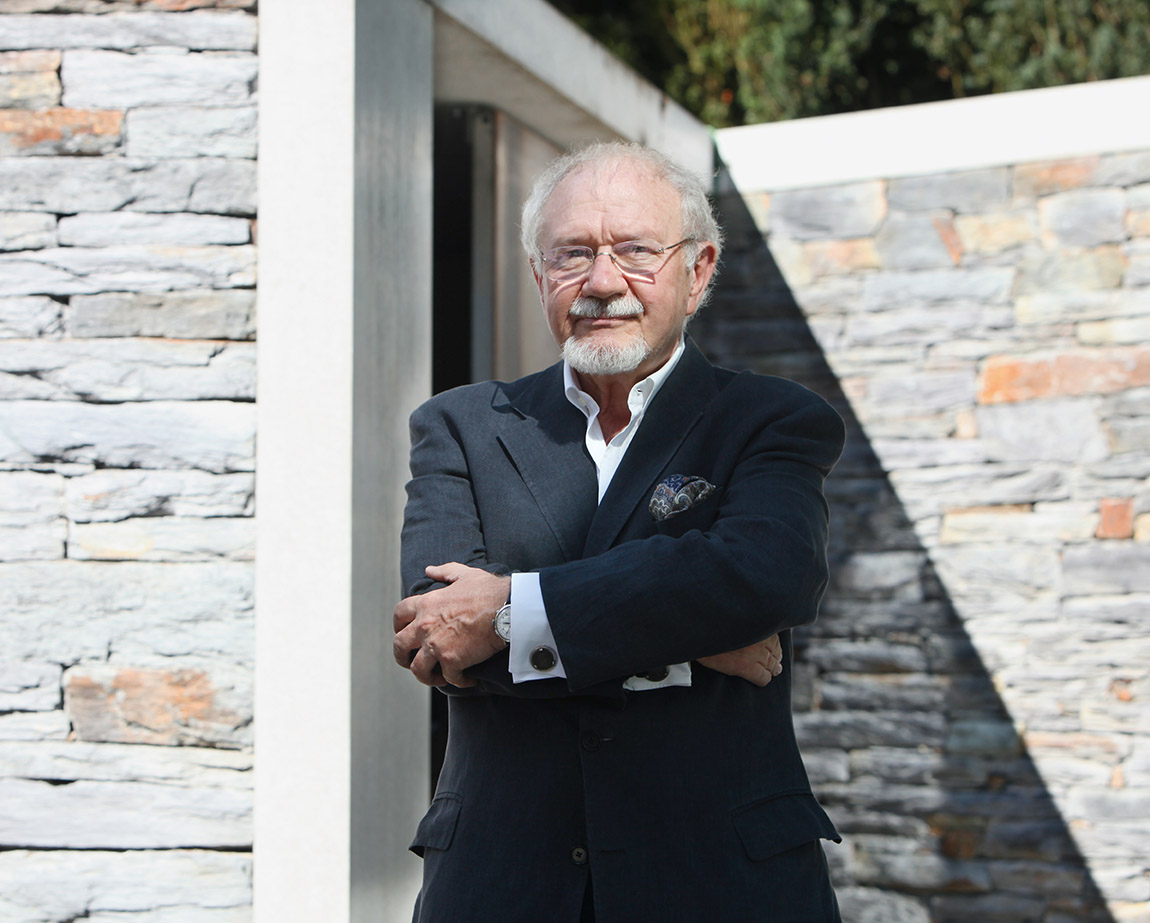
Hans Peter Gresser vor der Feldkapelle in Wiesbaden. Foto: Alexandra Repp
www.gresser-architects.com
"Hausaufgaben": ISBN 978-3737405034
Subscribe to Our Newsletter
Receive our monthly newsletter by email

